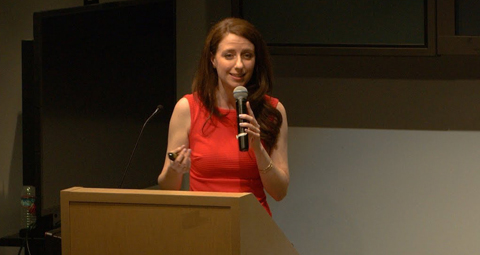BY James Farrell | March 22 | ![]() 0 COMMENTS
0 COMMENTS ![]() print
print

Canadian pro-life speaker lays out arguments against assisted suicide
A more caring society, not assisted suicide, is the solution to end of life care, Canadian pro-life apologist Stephanie Gray told a Glasgow audience last week.
Ms Gray, who has delivered more than 900 pro-life presentations, was giving the Strathclyde Students for Life Society talk at the university’s Royal College on Wednesday March 13.
The experienced speaker used the story of two English rugby players, Dan and Matt, who both suffered debilitating injuries, to illustrate a core principle behind her argument against assisted suicide—that we have the freedom to choose how to respond to situations we are in
“Dan became paralysed from the chest down and Matt became paralysed from the neck down and required a ventilator. Today Dan is dead and Matt is thriving,” Ms Gray said.
“Dan travelled to Switzerland where he went to a euthanasia clinic. Matt volunteers with children at physiotherapy sessions, he raises money for spinal cord research, he is a motivational speaker and a writer.”
“If in our suffering we find little to no meaning, you’re going to have a very high chance of despair.
“That’s ultimately what would lead someone to suicide,” Ms Gray said.
“If we are to convince people not to commit suicide the way Dan did, our job is to help people find meaning in their suffering.”
Prevention
The talk sought to inform the pro-life audience how to argue effectively against assisted suicide.
Ms Gray said that the main ‘reasons’ given for assisted suicide are choice, physical pain, emotional pain, being a burden, and fear of a bad death, and for each of these she used the stories of real people to highlight the appropriate response.
With choice she used a video telling the story of a man who attempted to jump from the Golden Gate Bridge to his death but was talked down by a passing police officer.
In that situation it was his choice to go ahead with suicide and he was prevented from doing so, Ms Gray said, adding that this raised the question, ‘Who gets suicide prevention and who gets suicide assistance?’
Society, Ms Gray argued, judges some people’s lives as being worth living and others as not, when in fact everyone should receive suicide prevention.
Addressing the argument that pain is a justification for assisted suicide, the Canadian said that pain management is a better solution, adding that even if pain cannot be fully removed a person can still live a meaningful life.
Lessening the burden
She highlighted as an example the case of Jonathan Pitre, a young boy who suffered from rare and incurable condition that caused him to feel constant pain.
But he spent his short, 17 years fighting the disease and raising awareness and money to try and find a cure.
When people feel like they are a burden our response has to be to lighten that burden, Ms Gray said.
Using the image of an elderly woman carrying bags and crossing the road, Ms Gray highlighted that our reaction should be to offer to help.
“Our reaction isn’t to say ‘oh she is a burden.’ When we love someone we lighten their burden,” she said.
Care and support
She also argued for better palliative care, pointing to the stark difference between an elderly care home and a children’s hospital.
“You often don’t smell children in a children’s hospital because their diapers are changed so quickly,” she said.
“How often in our elder care homes do we smell smells and it’s not that we cannot clean the elderly, it’s that we’re not responding with the same care to our elders.
“So I would suggest that it’s us that has to change—it’s how we respond to the needs of others.”
Ms Gray left the audience with words of practical advice: “You are not responsible to do what you cannot do but you are very responsible to do what you can.
“What I would suggest is that all of us to some degree and some capacity can invest time in helping those who are lonely, disabled, elderly or in some capacity neglected.
“Our job is to surround those who are lonely, sick, elderly or disabled so that they don’t desire to take death but rather live full lives until death takes them.”










